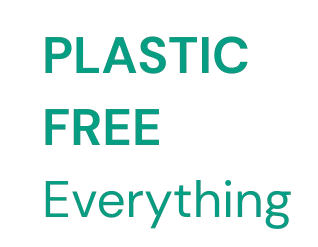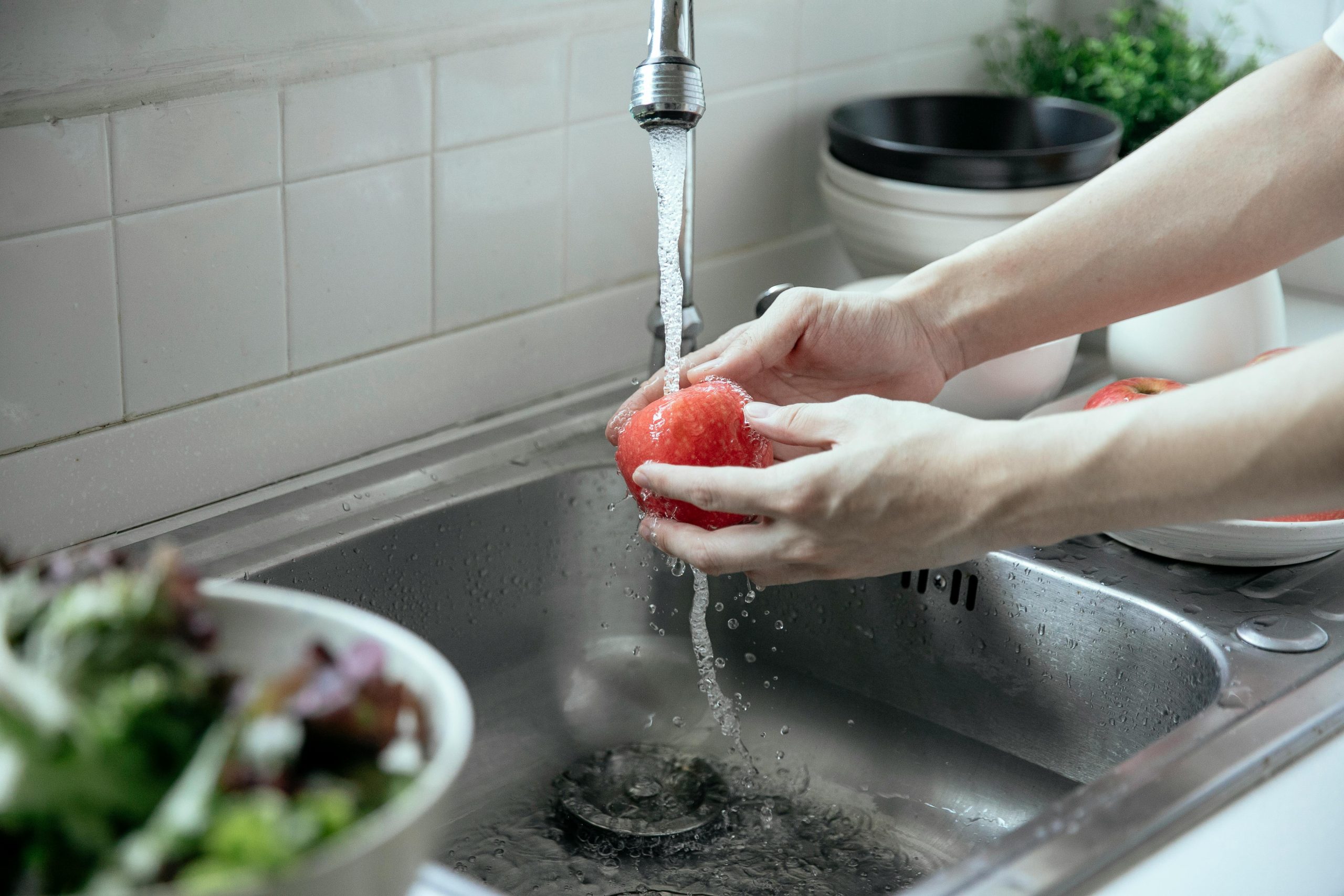The Best Whole House Water Filtration Systems to Remove Microplastics and Other Contaminants From Your Tap Water
As awareness grows around the health risks of microplastics and other chemicals that can be in your water, many homeowners are turning to whole-house water filtration systems to ensure cleaner, safer water from every tap.
To effectively remove contaminants, including microplastics from your tap water, filtration systems must include advanced filters such as fine sediment filters, carbon blocks, and sometimes ultrafiltration membranes. Below is a curated list of high-performing whole-house systems that meet these standards:
Key Takeaways
- Reverse Osmosis systems are going to filter out microplastics more effectively than Whole House Water Filtration Systems
- If you’re only worried about the water you drink, a Reverse Osmosis system is going to be more cost effective route to filter your water and the best choice for you.
- If you want your entire water supply filtered, then a Whole House Filtration System is going to be required
- If your worried about the quality of your water supply, you should get it tested by a professional before you purchase a whole house system.
Our Recommended Whole House Water Filtration Systems and Reverse Osmosis Systems
- The Best Under-Sink Reverse Osmosis System: Waterdrop G3P600
- The Best Countertop Reverse Osmosis System: The Bluevua Reverse Osmosis System
- The Best Budget Whole House Water Filtration System: Waterdrop 3-Stage system
- The Best Overall Whole House Water Filtration System: iSpring Whole Home Water Filtration System
- Recommended 1 Micron Filter for Your Whole House System: Hydronix CB-45-2001
Why You Should Use a Whole House Water Filtration System
Clean water is essential to our health, yet many homeowners assume that the water from their tap is already safe. In reality, trace contaminants, microplastics, and chemical residues are increasingly being found in municipal and well water systems. A whole house water filtration system treats all the water entering your home, providing peace of mind and ensuring your family has access to safer, cleaner water from every faucet.
Whole house water filters don’t just improve drinking water—they also reduce your exposure to potentially harmful substances in the water you bathe in, cook with, and use for cleaning.
Contaminates That Could Be in Your Tap Water
While regulations from the EPA and local utilities are designed to keep drinking water safe, there are still many contaminants that can make their way into your tap. These contaminants can affect not only the taste and odor of your water but also your health and the lifespan of your appliances.
| Contaminant | Potential Health Risks | Common Source |
|---|---|---|
| Microplastics | Unknown long-term effects; possible endocrine disruption | Degraded plastics in supply chains |
| Lead | Neurological damage, developmental issues | Aging pipes and solder |
| Chlorine & Chloramines | Respiratory issues, unpleasant taste & odor | Disinfection by water utilities |
| PFAS (“Forever Chemicals”) | Cancer, thyroid disruption, reproductive harm | Industrial runoff, firefighting foam |
| Heavy Metals (Mercury, Arsenic) | Kidney damage, cancer, organ failure | Natural deposits, industrial waste |
| VOCs (Volatile Organic Compounds) | Liver/kidney damage, cancer | Industrial solvents, agricultural runoff |
| Bacteria & Parasites | Gastrointestinal illness | Groundwater contamination |
Investing in a whole house water filter is like investing in peace of mind. You’re not just improving the taste of your water; you’re protecting your family from potential health risks and extending the life of your plumbing and appliances. It’s a win-win situation, really.
The Different Kind Of Water Filtration Systems for your Home.
Whole house water filters come in different types, each designed to target specific contaminants. Choosing the right system depends on your local water quality, desired level of purification, and your household’s water usage.
As you’re looking to invest in a water filtration system for your home, there are going to be two primary types of filtration paths:
- Filtering the water as it comes into your home. This is usually accomplished with a Whole House Water Filtration System.
- Filtering the water as it exits your plumbing. This is usually accomplished with a Reverse Osmosis System.
Whole House Water Filters
Whole House Water Filtration systems are usually installed where the main water line enters the home, ensuring all downstream taps and appliances receive filtered water.
Standard whole house water filtration systems typically combine sediment filters, activated carbon, and KDF media (a copper-zinc alloy) to remove:
- Sediment (sand, rust, silt)
- Chlorine, taste and odor
- Some heavy metals
- VOCs
- Microplastics (down to 1 micron in size, depending on the filter)
They help extend the life of your appliances by reducing scale buildup and can even improve the taste and smell of your water. It’s a pretty comprehensive solution for improving your overall water quality.
When evaluating water filtration systems for your house, the variables you will usually look for are:
Filtration Level (Micro‑, Ultra‑, Nano‑, and Reverse Osmosis)
- Microfiltration (pore size ≈0.05–5 µm): Removes parasites and some bacteria, but not viruses or chemicals CDC. Most residential whole house filters will filter at 5µm.
- Ultrafiltration (≈0.001–0.05 µm): Captures parasites and bacteria, with limited virus removal CDC.
- Nanofiltration (≈0.008–0.01 µm): More comprehensive—removes parasites, bacteria, most viruses, and some chemicals CDC.
- Reverse Osmosis (≈0.0001 µm): Offers the highest level of filtration, removing parasites, bacteria, viruses, and many dissolved chemicals (e.g., lead, fluoride, arsenic, salts) CDC.
UV Disinfection
- Uses ultraviolet light to inactivate parasites, bacteria, and viruses—effective when paired with a pre-filter CDC. It does not remove chemicals.
Water Softeners
- Remove hardness minerals (calcium and magnesium) to protect plumbing and improve soap performance—not designed to remove germs or harmful chemicals.
There is a LOT to consider when selecting a water filtration system for your house, so we’ve complied our recommendations below.
Reverse Osmosis (RO) Systems
RO systems are a step up in filtration power as they are one of the most effective filtration methods available. A reverse osmosis system is going to be superior to a whole house water filtration system in filtering out microplastics from your drinking water. That being said, they are usually going to filter your water at the point of exit of your home, rather than the point of entry.
An RO system uses a semi-permeable membrane to remove up to 99% of contaminants from your tap water, including:
- Microplastics (down to 0.0001 microns)
- Heavy metals (lead, arsenic, mercury)
- PFAS and VOCs
- Fluoride
- Nitrates and dissolved salts
While RO systems are traditionally point-of-use (under-sink or countertop), whole house RO setups do exist. However, they are expensive and require significant maintenance, including pre-filtration stages and water storage tanks.
RO systems do have a couple of drawbacks. They can be more expensive to install and maintain than standard whole house filters, and they also tend to produce wastewater during the filtration process. However, for many people, the peace of mind that comes with knowing their water is as clean as possible is worth the extra cost and effort.
What Kind of Whole House Filter Removes Microplastics from Your Tap Water?
To effectively remove microplastics, your filtration system should include one or more of the following:
- Sub-micron sediment filters (rated at 1 micron or smaller)
- Activated carbon block filters
- Reverse osmosis membranes
Most standard whole house systems use a combination of a 5-micron sediment filter followed by carbon filtration, which will catch many microplastics but not the smallest particles.
To maximize effectiveness, we recommend pairing a whole house filter with a point-of-use RO system at your kitchen sink or looking for a whole house system that has a filtration system for sub 1 microns.
The Best Whole House Water Filtration Systems
Choosing the right water filtration system for home can feel overwhelming, but it’s a worthwhile investment for your health and home. You want to make sure you’re getting the best whole home water filtration for your specific needs. There are many options available, each with its own strengths. Let’s explore some of the top contenders in the realm of whole house water purification systems.
Best Under Sink Reverse Osmosis System: Waterdrop G3P600 Reverse Osmosis System
Our favorite Reverse Osmosis (RO) System is the Waterdrop G3P600. It’s highly rated, relatively affordable in a mid level price point, and will effectively filter out all of the microplastic contamination from your tap water (plus a whole lot of other concerning items)
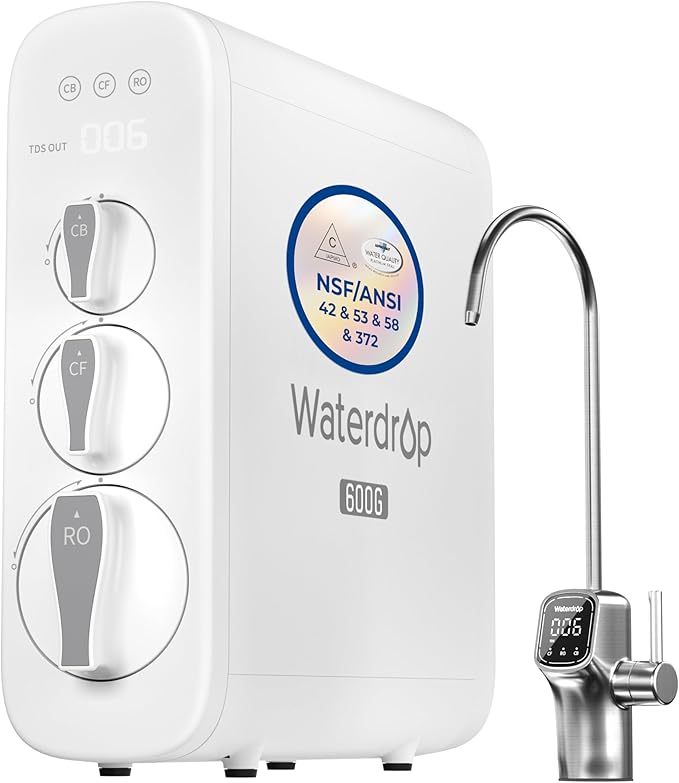
- Type: Under-sink RO system
- Filtration rating: 0.0001 microns
- Features:
- Smart LED filter indicators
- Tankless design with fast water flow
- Removes microplastics, lead, chlorine, fluoride, PFAS
- Certifications: NSF 58 and 372 certified
- Ideal for: Homes seeking highly purified drinking water with modern features
Best Countertop Reverse Osmosis System: Bluevua Reverse Osmosis System Countertop Water Filter
For those who prefer a non-permanent or easily portable solution, a countertop RO system is ideal. The Bluevua Reverse Osmosis System offers convenience and effective filtration without the need for complicated installation. It’s a great option for renters or anyone who wants to enjoy purified water without altering their plumbing.
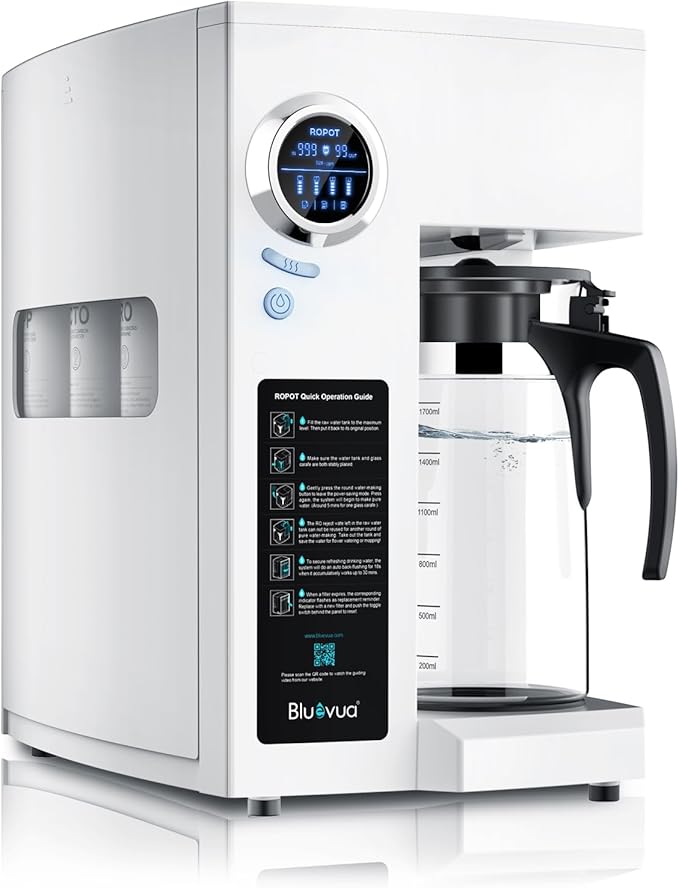
- Type: Portable countertop RO system
- Filtration rating: 0.0001 microns
- Features:
- No installation required
- BPA-free, glass carafe
- Filters over 1,000 known contaminants
- Ideal for: Renters, small households, and portable use
Best Budget Water Filtration System: Waterdrop 3-Stage Whole House Water Filter System
If you’re looking for an affordable yet reliable Whole House Water Filter, the Waterdrop 3-Stage system is worth considering. It’s designed to remove sediment, chlorine, and other common contaminants, providing cleaner water for your entire home. This system is known for its ease of installation and maintenance, making it a user-friendly option for homeowners.
It’s filtration rating is 5 microns, so it will pick up a lot of microplastics from your Tap Water, but it won’t be as comprehensive as a system with a filter with lower micro rating or a RO system.
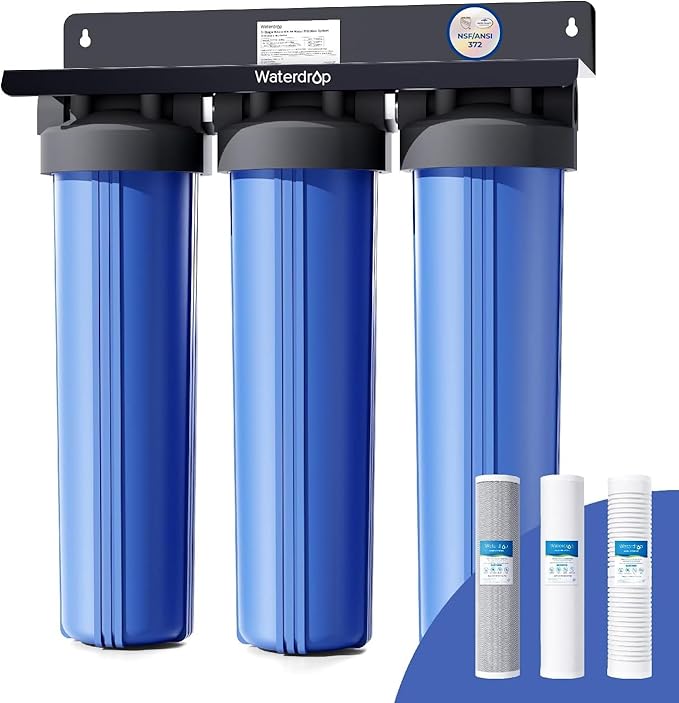
- Type: Whole house
- Filtration rating: 5 microns (with multi-stage reduction)
- Stages:
- PP sediment filter
- Granular activated carbon filter
- Carbon block filter
- Removes: Sediment, chlorine, VOCs, rust, microplastics
- Flow rate: 15 GPM
- Ideal for: Budget-conscious households wanting broad filtration coverage
Overall Best Pick: iSpring Whole House Water Filter System
One of the popular choices is the iSpring Whole Home Water Filtration System. This system is designed to remove common contaminants like chlorine, sediment, rust, pesticides, herbicides, and even industrial solvents. It’s built with DIY installation and maintenance in mind, which is a plus if you’re comfortable with a bit of plumbing. The system typically features a multi-stage filtration process:
- A first-stage polypropylene sediment filter, which filters down to 5 microns.
- Second and third-stage CTO Carbon Block filters that meet NSF/ANSI standards.
- High capacity, often around 100,000 gallons, which should last a family of four for about a year.
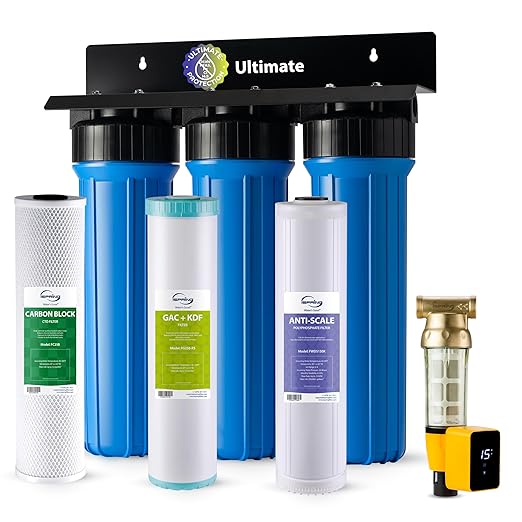
- Type: Whole house
- Filtration rating: 5 microns
- Stages:
- Sediment filter
- Carbon block filter (x2)
- Removes: Chlorine, rust, sediment, VOCs, microplastics
- Certifications: NSF/ANSI Standard 42
- Ideal for: Households wanting a more premium product to provide water filtration for your home.
Upgrade Your Whole House System with a 1 Micron Filter
Most whole house systems will come with a 5 micron filter. You can purchase a replacement 1 micron filter that will filter out smaller particulates, which is specifically helpful for filtering out microplastics.
Conclusion
As concerns about microplastics and other contaminants in tap water grow, investing in a high-quality whole house water filtration system is one of the most effective ways to protect your health and home. Whether you choose a multi-stage sediment and carbon system or supplement with a reverse osmosis unit for drinking water, the goal is to create multiple layers of defense against the invisible threats in our water supply.
With systems like Waterdrop and iSpring offering fine micron filtration, and RO units providing near-complete contaminant removal, there’s a solution for every household and budget.
Frequently Asked Questions
Do standard whole house filters remove microplastics?
Most standard systems remove larger microplastics (down to 5 microns), but may miss the smallest particles. Systems rated at 1 micron or less are more effective.
Is reverse osmosis worth the investment?
Yes, particularly for drinking water. RO systems remove up to 99% of all contaminants, including the smallest microplastics, PFAS, and heavy metals.
How often do I need to replace filters?
This varies by system, but generally:
- Sediment filters: every 6 months
- Carbon filters: every 6–12 months
- RO membranes: every 2–3 years
Can I install a whole house filter myself?
Some systems are DIY-friendly, especially those with clear instructions and universal fittings. However, more complex installations may require a licensed plumber.
Are microplastics harmful to health?
Research is ongoing, but studies show microplastics can accumulate in organs and may disrupt hormones or cause inflammation over time.
Should I filter both drinking and shower water?
Yes. Inhalation of contaminants and skin exposure are additional pathways for absorption. A whole house system ensures all water sources are protected.
